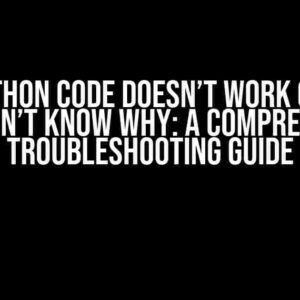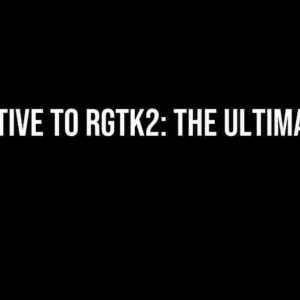- The Frustrating Phenomenon of For Loops Getting Skipped During Runtime
- Theories Behind the Skipped Iterations
- Solution 1: Verify Loop Initialization and Termination Conditions
- Solution 2: Avoid Scope and Hoisting Issues
- Solution 3: Tame Asynchronous Code with Promises and Async/Await
- Solution 4: Identify and Resolve Variable Shadowing
- Common Gotchas and Edge Cases
- Conclusion
The Frustrating Phenomenon of For Loops Getting Skipped During Runtime
Have you ever experienced the thrill of watching your carefully crafted for loop execute perfectly in the code editor, only to have it mysteriously skip iterations when you run the program? You’re not alone! This article will delve into the possible reasons behind this phenomenon and provide you with actionable solutions to tackle the issue head-on.
Theories Behind the Skipped Iterations
Before we dive into the solutions, let’s explore some common reasons why for loops might get skipped during runtime:
- Incorrect Loop Initialization: A mismatch between the loop counter and the termination condition can cause the loop to skip iterations or even run indefinitely.
- Scope and Hoisting: JavaScript’s hoisting mechanism can sometimes lead to unexpected behavior, especially when dealing with variables declared inside the loop.
- Asynchronous Code and Callback Hell: When working with asynchronous functions, the loop might get skipped due to the non-blocking nature of these functions.
- Variable Shadowing: Accidental redeclaration of variables can affect the loop’s execution, leading to skipped iterations.
Solution 1: Verify Loop Initialization and Termination Conditions
A thorough examination of your loop initialization and termination conditions is crucial to ensure the loop executes as intended. Here’s an example of a correctly initialized and terminated for loop:
for (let i = 0; i < 10; i++) {
console.log(`Iteration ${i}`);
}In this example, the loop starts from 0, increments by 1, and stops when it reaches 10. Make sure to:
- Declare the loop counter with the correct data type (e.g., `let`, `const`, or `var`).
- Set the initial value of the counter to the correct starting point.
- Define the termination condition correctly (e.g., `i < 10` or `i <= 10`).
- Increment or decrement the counter correctly (e.g., `i++` or `i–`).
Solution 2: Avoid Scope and Hoisting Issues
To prevent scope and hoisting issues, follow these best practices:
- Declare variables outside the loop: If possible, declare variables outside the loop to avoid re declarations and ensure they’re accessible within the loop.
- Use `let` or `const` instead of `var`: These keywords provide better scoping and reduce the risk of hoisting issues.
- Avoid reassigning the loop counter: Refrain from reassigning the loop counter within the loop, as this can lead to confusion and unexpected behavior.
Solution 3: Tame Asynchronous Code with Promises and Async/Await
When working with asynchronous functions, use promises or async/await to ensure the loop executes correctly:
async functionloopExample() {
for (let i = 0; i < 10; i++) {
await setTimeout(() => {
console.log(`Iteration ${i}`);
}, 1000);
}
}
loopExample();In this example, we use async/await to pause the execution of the loop until the `setTimeout` function completes. This ensures the loop iterates correctly, even with asynchronous code.
Solution 4: Identify and Resolve Variable Shadowing
To avoid variable shadowing, follow these guidelines:
- Avoid redeclaring variables with the same name: Be mindful of variable names and avoid redeclaring them within the same scope.
- Use unique and descriptive variable names: Choose variable names that clearly indicate their purpose and avoid conflicts.
- Use tools like ESLint or TypeScript: These tools can help identify potential issues with variable shadowing and provide suggestions for improvement.
Common Gotchas and Edge Cases
Keep an eye out for these common gotchas and edge cases that can cause for loops to get skipped during runtime:
| Gotcha/Edge Case | Description | Solution |
|---|---|---|
| Looping over an empty array | The loop will skip iterations if the array is empty. | Check if the array is empty before iterating over it. |
| Using `continue` or `break` statements | These statements can cause the loop to skip iterations or exit prematurely. | Use `continue` and `break` judiciously and ensure you understand their impact on the loop. |
| Floating-point precision issues | Floating-point arithmetic can lead to inaccurate results, causing the loop to skip iterations. | Use integer arithmetic or libraries like `decimal.js` to ensure accurate calculations. |
Conclusion
For loops getting skipped during runtime can be frustrating, but by understanding the possible reasons behind this phenomenon and applying the solutions outlined in this article, you’ll be well-equipped to tackle the issue head-on. Remember to:
- Verify loop initialization and termination conditions.
- Avoid scope and hoisting issues.
- Tame asynchronous code with promises and async/await.
- Identify and resolve variable shadowing.
- Watch out for common gotchas and edge cases.
By following these guidelines, you’ll ensure your for loops execute correctly, and you’ll be writing robust, reliable code in no time!
Here are 5 Questions and Answers about “For loops get skipped during runtime”:
Frequently Asked Question
Get stuck in the loop? Don’t worry, we’ve got the answers to help you debug!
Why does my for loop get skipped during runtime?
This might happen if your loop counter variable is initialized with a value that meets the loop termination condition. For instance, if you start your loop with `i = 10` and your condition is `i < 10`, the loop will be skipped because `i` already meets the condition. Double-check your initialization and termination conditions!
What if I’m using a for-each loop and it gets skipped?
If you’re using a for-each loop, make sure the collection you’re iterating over is not empty. If the collection is empty, the loop will be skipped. Additionally, ensure that the collection is properly initialized and populated before the loop.
Can an exception thrown inside the loop cause it to get skipped?
Yes! If an exception is thrown inside the loop and not handled properly, it can cause the loop to be skipped. This is because the exception will terminate the loop execution. Make sure to handle exceptions correctly using try-catch blocks.
What if I’m using a conditional statement inside the loop and it gets skipped?
If you have a conditional statement (e.g., if-else) inside the loop, and the condition is not met, the loop will be skipped. Ensure that the condition is correctly evaluated and that the loop is not terminated prematurely.
How can I debug a for loop that gets skipped during runtime?
To debug a skipped for loop, use a debugger or add print statements/output logs to inspect the values of variables and expressions at different points in the code. This will help you identify the reason why the loop is being skipped.



